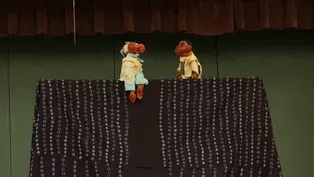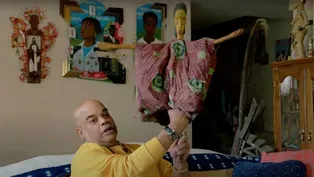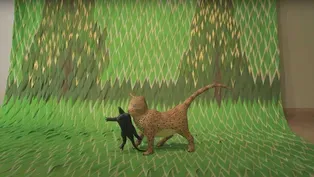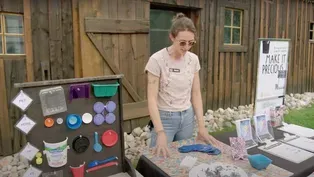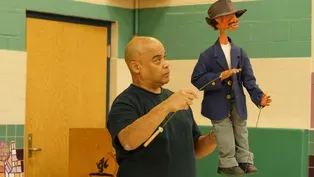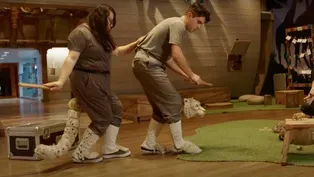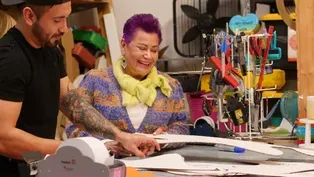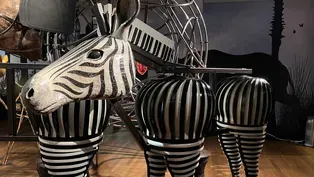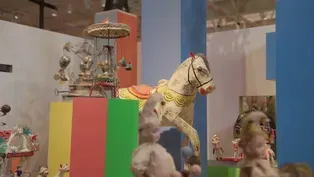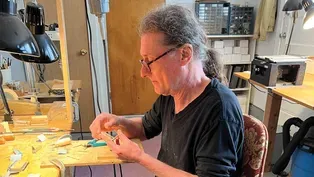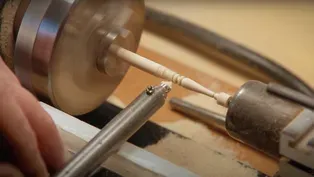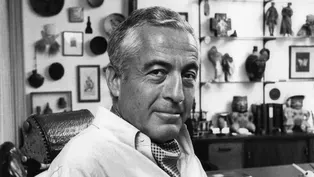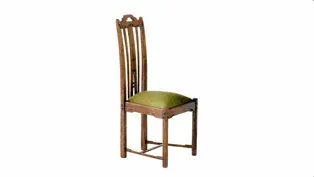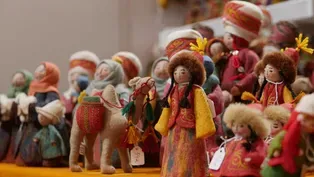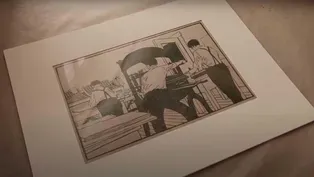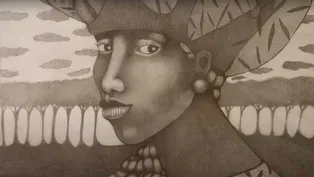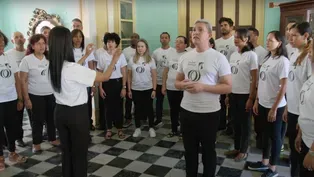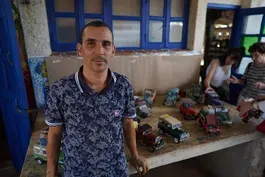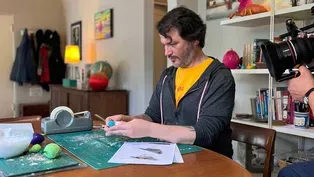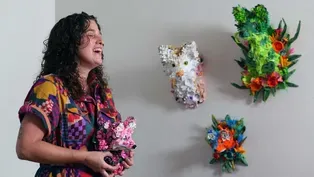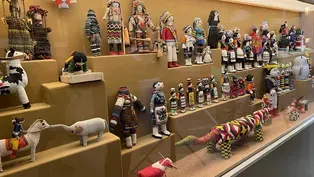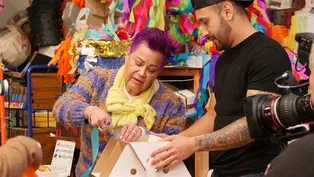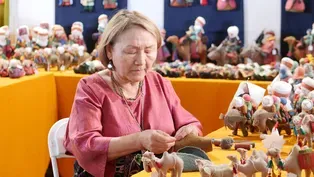
Cuban artist Leandro Gómez Quintero segment
Clip: Season 15 | 13m 43sVideo has Closed Captions
Small scale model cars by Cuban artist Leandro Gómez Quintero
In Baracoa, Cuba, we learn about the model vehicles of artist Leandro Gómez Quintero. Leandro crafts his faithful recreations of vehicles like the iconic Willys Jeep with intricate detail and accuracy, using found materials to tell the story of Cuba and her people through his art. Segment from MINIATURES episode
Problems with Closed Captions? Closed Captioning Feedback
Problems with Closed Captions? Closed Captioning Feedback

Cuban artist Leandro Gómez Quintero segment
Clip: Season 15 | 13m 43sVideo has Closed Captions
In Baracoa, Cuba, we learn about the model vehicles of artist Leandro Gómez Quintero. Leandro crafts his faithful recreations of vehicles like the iconic Willys Jeep with intricate detail and accuracy, using found materials to tell the story of Cuba and her people through his art. Segment from MINIATURES episode
Problems with Closed Captions? Closed Captioning Feedback
How to Watch Craft in America
Craft in America is available to stream on pbs.org and the free PBS App, available on iPhone, Apple TV, Android TV, Android smartphones, Amazon Fire TV, Amazon Fire Tablet, Roku, Samsung Smart TV, and Vizio.
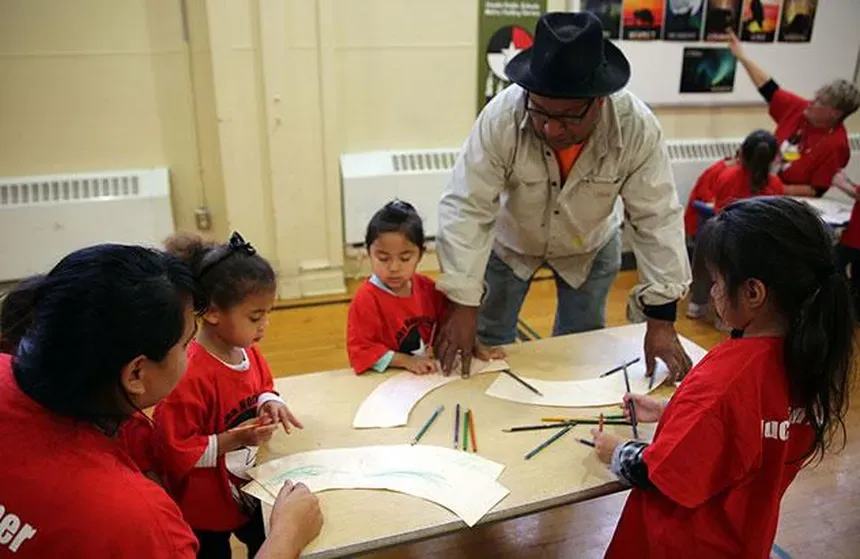
Education Guides
Download Craft in America education guides that educate, involve, and inform students about how craft plays a role in their lives, with connections to American history and culture, philosophies and science, social causes and social action.Providing Support for PBS.org
Learn Moreabout PBS online sponsorship♪♪ My wife, Peggy, and I are here to visit Leandro Gómez.
[Singers singing in Spanish] ♪♪ Baracoa is very isolated.
It really can only be reached by this road called La Farola.
♪♪ La Farola was built after the revolution.
Before that, the only way to reach Baracoa was by boat.
♪♪ I grew up in Cuba, and then my family moved to New York when I was 12.
My father spent time in this town of Baracoa during World War II, and he always told me that this was the most beautiful place in Cuba.
♪♪ Leandro lives across the street from the seawall, so the ocean is right there.
Leandro: Qué bueno, qué bien se ve.
Stuart: His wife is a doctor, and they have two kids.
Leandro: Yo nací aqui en Baracoa en 1976, y siempre he vivido en esta misma casa, y me crie aquí, en el mismo barrio.
Stuart: Leandro!
!¡¡Oye!
Leandro: ¿¿Stuart?
No, no es posible, mi hermano.
Stuart: ¿¿Cómo estás?
Leandro: !¡¡Oye!
Peggy: !¡¡Hola!
Leandro: !¡¡Peggy!
Peggy: ¿¿Cómo estás?
The first time I saw Leandro's work, I was here without Stuart in 2014, and I wanted to get him something special, and I walked into a gallery, and there was this red Jeep on a pedestal, so I said, "Oh, this is amazing."
So I took it back home to Stuart, and he said, "Well, next time, I'm going with you."
Stuart: And we hit it off immediately because he's a car guy and I'm sort of a car guy.
I have a Jeep myself.
Leandro: Esto es lo nuevo.
Stuart: !¡¡Coño!
Leandro: Esto acá es una guagua cubana.
Stuart: Ajá.
Leandro: EÉÉl está roto.
La gente está esperando que se arregle.
Stuart: Ajá.
Leandro: Entonces, cuando se arregle, la gente se monta otra vez.
Yo soy profesor de filosofía e historia.
Pero yo ya abandoné el trabajo.
Y dije: "me voy a dedicar por completo, por completo a hacer carros."
O sea, yo decía: "Voy a jugármelo todo, voy a ser feliz haciendo lo que me hace feliz hacer".
Stuart: Just as a painter paints a landscape that he sees, he creates these sculptures based on these vehicles that he sees, and then he adds his own creativity to them.
Leandro: Esta carga madera para hacer muebles.
Saco con vianda, que el chofer trae para la casa, para comer.
Los carros cuentan la historia porque forman parte de la historia.
Este, particularmente, el general Dwight Eisenhower dijo que el Willys Jeep había sido una de las mayores contribuciones del ejército norteamericano en la segunda guerra mundial.
El Jeep Willys entró en Cuba por la base naval de Guantánamo.
en lotes que se vendían a la población.
Stuart: Y enséñame cómo es esto, cómo tú haces estas cosas.
Leandro: Estudio en sus componentes para después entonces, saber cómo armarlo yo.
Mi materia prima básica y fundamental es el cartón.
Por eso es que son tan ligeros los modelos.
Porque es cartón.
EÉÉl está hecho al detalle en cuanto a las proporciones del carro.
básicas del original.
el chasis, el diferencial, la caja de velocidad, el tubo de escape.
Ellos transportan varias cosas que las personas tengan para transportar.
Esto puede ser un saco con alimentos.
Esto es parte de un techo de una casa, que posiblemente, el hombre está armando.
Estas son maderas para hacerla, que las personas transportan mucho.
Stuart: Because of his ability to depict these vehicles as realistically as possible, he's showing us everyday life in Cuba.
[Horn honks] American cars stopped coming into Cuba at the end of 1959, but Cubans have done an incredible job of making these cars survive.
Leandro: !¡¡Oye, Gallego!
Gallego: !¡¡Ah!
Leandro: ¿¿Cómo está todo?
Gallego: Bueno, ya tú sabes.
Leandro: Ay, caramba.
Gallego: Cada día mejor.
Leandro: Qué cosa más linda tú tienes aquí, chico.
Gallego: Este carro fue de mi abuelo.
Un Willys del año 1952.
Muy noble, un carro muy noble, muy fuerte.
Leandro: !¡¡Ah!
Tiene el motor original.
Tiene muchas piezas y partes originales.
Gallego: ¿¿Esto?
Esa es la bomba de gasolina.
Leandro: La bomba de gasolina.
Gallego: Este es el filtro.
Leandro: Esta pieza original también, ¿¿no?
Gallego: Todo es original.
Leandro: Esto, original, original.
Y a los nueve años, aprendí a conducirlo cuando apena alcanzaba el timón.
Leandro: ¿¿El tapa plana original, Gallego?
Gallego: Sí.
Lo había restaurado tal y como lo fabricaron.
Allá vamos.
♪♪ Leandro: Yo recuerdo, yo era muchacho, tendría nueve, diez años.
y ver, en las noches, la silueta del Willys que pasaba por la calle, solo alumbrado con la luna.
[Horn honks] Y yo decía: "Yo amo ese carro".
Ahora, esa forma, esa silueta era como... como una novia, como una muchacha que me encantaba.
Yo en ocasiones me pregunto qué haría yo en otro país, en otro lugar, con mucho más recursos.
Pero entonces digo: "No sería mi trabajo igual".
Los dueños de los carros en Cuba, si no tienen la pieza de fábrica ideal, le ponen la pieza que tienen o la pieza que encuentran.
Si no tienen la pintura ideal, le ponen la pintura que tienen.
Me pasa a mí también.
Entonces utilizo también el fango, como si hubieran transitado por un camino.
Stuart: Leandro follows the Cuban methodology of resolving or, as they say, resolver.
If you don't have something, you just find some other way to make it work, and so he carves tires out of packing Styrofoam that people throw away.
Leandro: Entonces, yo simplemente, voy y la recojo y le doy una segunda oportunidad.
Yo reciclo o recojo materiales que me encuentro en la calle.
Las personas decían: "Tiene problemas, ¿¿qué le pasa a éste que recoge basura?
Stuart: It's just amazing to me that he finds these materials and he makes a complete work of art.
Leandro: Para mí, esto es oro.
Yo lo pico.
Y amarrarla, ponerla aquí.
Es la lona del carro que lo tapa.
Porque así ocurre en la vida real en Baracoa.
[Waves crashing] Yo nunca me imaginé la magnitud que iba a tener el huracán Matthew.
El mar entraba a la casa con una normalidad.
Entraba por una puerta y salía por la otra, en la otra calle.
Cuando el ojo pasó por aquí, pudimos escapar de la casa.
Al amanecer, los ojos de la gente mirando, lo que había quedado, lo indecible.
Pertenencias de las personas regado por donde quiera, en toda la calle.
Puertas, persianas, de todo.
Solo me quedaron las cuatro paredes.
Todo lo demás lo perdí.
[Horn honks] Stuart: Peggy and I came here right after Hurricane Matthew, and we were the first tourists that came back to Baracoa.
Leandro: Y recuerdo que en la conversación salió eso.
Si vas al mercado de arte, tienes la posibilidad de reconstruir tu casa.
Peggy: We helped him apply to the market, and he was accepted.
Stuart: He raised enough money to rebuild the back of the house... Leandro: Esto es de concreto sólido.
Stuart: and it will probably withstand another hurricane.
Leandro: Gracias al mercado.
Peggy: ¿¿Con aire acondicionado?
Leandro: Con aire acondicionado.
Stuart y Peggy me cambiaron la vida por completo.
Cambiaron mi vida totalmente.
Yo fui tocado.
Entonces hacemos amarillo y gris los detalles, con las bujías, todas las cositas.
Esa batería te quedó buena.
Esa batería está buena ahí.
Yancer: Gracias a San Leandro, trabajo aquí hace cinco años.
Leandro: Y a esto se le pudiera hacer la tapa del motor.
Yancer: Me ha enseñado mucho la técnica del trabajo.
Cada día lo hacemos con más calidad y con más perfección.
Yo todas las noches me digo: "¿¿Qué tú haces?
¿¿Por qué tú no vas a clase?".
Y yo, bueno, porque yo me decidí por hacer estos objetos, de cartón y de reciclaje y, a la vez, enseñarles a las personas que trabajan conmigo para que esta herencia quede, hacer esto.
♪♪ [Singing in Spanish] ♪♪ Stuart: Leandro is very serious about his work.
When people see the work, they want to know more about Cuba.
♪♪ ♪♪ Leandro: Y yo pensé que iba a morir así, un joven irresponsable.
Pero mis sueños se han hecho realidad.
Tengo mi familia al lado.
Está bien.
Tengo un trabajo que me gratifica.
Está bien.
Hago lo que quiero hacer.
Está bien.
♪♪ Yo ni siquiera tengo carro.
No he podido comprarme un carro porque realmente cuestan mucho.
Pero que tengo una bicicleta.
Quizá algún día pueda.
Me compraría un Willys.
♪♪ [Cheering] [Horn honks]
Woodblock print & marionette maker Gustave Baumann segment
Video has Closed Captions
Clip: S15 | 12m 16s | Multidisciplinary artist, Gustave Baumann, was deeply inspired by Santa Fe (12m 16s)
Underground Railroad, Not a Subway by Schroeder Cherry
Video has Closed Captions
Clip: S15 | 25m 34s | Schroeder Cherry's puppetry performance, Underground Railroad, Not a Subway (25m 34s)
Schroeder Cherry's Civil Rights Childrens Crusade
Video has Closed Captions
Clip: S15 | 9m 53s | Schroeder Cherry's puppetry performance, Civil Rights Childrens Crusade (9m 53s)
Schroeder Cherry's African Puppets
Video has Closed Captions
Clip: S15 | 2m 36s | Artist, puppeteer, museum educator Schroeder Cherry on African puppets in his collection (2m 36s)
Roberto Benavidez on creating piñatas & "piñathkos"
Video has Closed Captions
Clip: S15 | 1m 49s | Artist Roberto Benavidez speaks with curator and art historian on his piñatas & piñathkos (1m 49s)
Recycling plastic through Precious Plastic program
Video has Closed Captions
Clip: S15 | 54s | Sustainability coordinator on recycling plastic through their Precious Plastic program (54s)
Puppeteer Schroeder Cherry segment
Video has Closed Captions
Clip: S15 | 10m 29s | How puppets can become vehicles of history & change: the work of Schroeder Cherry (10m 29s)
Puppeteering the snow leopard at Noah's Ark
Video has Closed Captions
Clip: S15 | 1m 47s | Kinetic designer Chris Green works with Noah's Ark educators on puppeteering snow leopard (1m 47s)
Piñata maker Lorena Robletto segment
Video has Closed Captions
Clip: S15 | 6m 14s | Lorena Robletto creates festive and creative piñatas with fair labor practices at her business, Amaz (6m 14s)
Noah's Ark at the Skirball segment
Video has Closed Captions
Clip: S15 | 12m 10s | Noah's Ark animals made using repurposed materials & Skirball's puppet fest (12m 10s)
Multiple Visions: A Common Bond
Video has Closed Captions
Clip: S15 | 1m 20s | Alexander Girard's folk art collection at Museum of International Folk Art Museum (1m 20s)
Miniaturist Mark Murphy segment
Video has Closed Captions
Clip: S15 | 10m 31s | Woodworker makes tiny furniture: Meet miniaturist Mark Murphy (10m 31s)
Mark Murphy shows us his miniature furniture
Video has Closed Captions
Clip: S15 | 2m 19s | Miniaturist Mark Murphy shows us his miniature 1/12th scale furniture (2m 19s)
Lloyd Cotsen & the Cotsen Children's Library segment
Video has Closed Captions
Clip: S15 | 5m 45s | Lloyd Cotsen founded the Cotsen Children’s Library at Princeton University (5m 45s)
Video has Closed Captions
Clip: S15 | 5m 22s | Lloyd Cotsen's collection of Chinese bronze mirrors, textiles, folk art, Japanese baskets (5m 22s)
International Guild of Miniature Artisans
Video has Closed Captions
Clip: S15 | 2m 27s | Barbara Davis on the International Guild of Miniature Artisans and their Guild School (2m 27s)
International Folk Art Market segment
Video has Closed Captions
Clip: S15 | 9m 5s | Meet artisans at the International Folk Art Market (9m 5s)
International Folk Art Market basket weaver
Video has Closed Captions
Clip: S15 | 1m 57s | Master basket weaver Nelsiwe Dlamini at International Folk Art Market (1m 57s)
Gustave Baumann's Printing the Democrat woodblock print
Video has Closed Captions
Clip: S15 | 1m 10s | Thomas Leech on Gustave Baumann's woodblock print, The Print Shop/Printing the Democrat (1m 10s)
Video has Closed Captions
Clip: S15 | 1m 16s | JELMA curator Schroeder Cherry invites artist Espi Frazier to show her work in the gallery (1m 16s)
Clip: S15 | 1m 23s | El Orfeon Santiago Chorus performance - bonus video from MINIATURES (1m 23s)
Cuban artist Leandro Gómez Quintero segment
Video has Closed Captions
Clip: S15 | 13m 43s | Small scale model cars by Cuban artist Leandro Gómez Quintero (13m 43s)
Calder Kamin on Austin Creative Reuse
Video has Closed Captions
Clip: S15 | 1m 18s | Artist Calder Kamin on how she discovered Austin Creative Reuse (1m 18s)
Artist Roberto Benavidez segment
Video has Closed Captions
Clip: S15 | 8m 24s | Roberto Benavidez's piñatas inspired by medieval manuscripts (8m 24s)
Video has Closed Captions
Clip: S15 | 10m 6s | Calder Kamin creates an art installation by reusing and recycling discarded plastic (10m 6s)
Alexander Girard's miniature folk art collection segment
Video has Closed Captions
Clip: S15 | 8m 6s | Alexander Girard's miniature folk art collection hopes to evoke common humanity. (8m 6s)
Video has Closed Captions
Preview: S15 Ep1 | 1m | Watch a preview of PLAY, streaming Dec 1, broadcast premiere Dec 29 (1m)
Video has Closed Captions
Preview: S15 Ep2 | 1m | Watch a preview of MINIATURES, streaming Dec 1, PBS broadcast premiere Dec 29 (1m)
Providing Support for PBS.org
Learn Moreabout PBS online sponsorshipSupport for PBS provided by:

